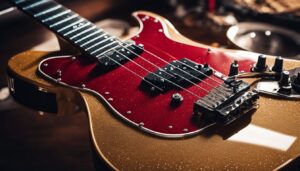As an Amazon Associate I earn from qualifying purchases.
Have you recently purchased an electric guitar and are feeling overwhelmed with understanding the different parts of an electric guitar? It’s a common challenge, especially as the electric guitar can be complex, encompassing over 20 distinct components.
This blog post is your crash course in understanding every piece of an electric guitar – from the body to the strings and everything in between. Let’s explore this electrifying instrument together!
Table of Contents
What are the different parts of an electric guitar?
The electric guitar consists of various parts, including the body, neck, headstock, fretboard, strings, tuning machines, nut, bridge, pickups and volume and tone controls.
Body
The body of an electric guitar performs a critical role in producing the instrument’s unique sound. Made typically from wood like mahogany, alder, or maple, this component is where the strings’ vibrations are transformed into electrical signals by pickups.
The shape and material of the body can significantly influence how these vibrations are transmitted, affecting the tone and resonance of the guitar. From solid-body types to semi-hollow variations, body design varies widely based on artists’ preferences and music genres.
Neck
The neck of an electric guitar is a crucial component that connects the body of the guitar to the headstock. It is usually made from a solid piece of wood and plays a significant role in determining the overall playability and feel of the instrument.
The neck consists of several important parts, including the fretboard or fingerboard, which is where you place your fingers to produce different notes and chords. Along the length of the neck, you will find frets, small metal strips embedded into the fingerboard that divide it into specific intervals to help guide your hand placement.
The neck also features markers on both sides, often dots or other shapes, which serve as visual guides for finding specific positions along the fretboard quickly. With its sturdy construction and functional components, such as frets and markers, the neck allows guitarists to navigate effortlessly while playing their favorite tunes.
Headstock
The headstock is located at the end of the neck and serves as the anchor point for the strings. It is usually wider than the neck and contains slots or holes where the strings are inserted and attached to tuning machines.
The headstock not only holds these tuners in place but also provides a surface for displaying the guitar brand logo. Having a sturdy headstock is important since it helps maintain tension on the strings, ensuring that they stay in tune while playing.
Fretboard
The fretboard, also known as the fingerboard, is a crucial part of an electric guitar. It is a flat and smooth piece of wood that runs along the neck of the guitar and serves as a playing surface for your fingers.
The fretboard usually has small metal bars called frets embedded into it, which divide the neck into different musical notes. By pressing down on these frets with your fingers, you can change the pitch or create different notes when you pluck or strum the strings.
The placement of these frets determines where each note will be played on the guitar. Additionally, some guitars have markers on the side or top of the fretboard to help players easily identify specific positions or chords without looking at their hands.
Frets
The frets are metal wires embedded into the fretboard of an electric guitar. They run parallel to the strings and divide the neck into specific intervals, allowing players to produce different notes and chords by pressing down on them with their fingers.
Each fret represents a semitone or half step, enabling musicians to play various scales and melodies in different keys. Frets also serve as visual markers along the fretboard, making it easier for guitarists to navigate the instrument while playing.
Strings
Strings are an essential part of an electric guitar. They are responsible for producing sound when they vibrate. The strings are made of metal, usually steel or nickel-plated steel, and come in different gauges or thicknesses.
Thicker gauge strings produce a heavier tone, while thinner gauge strings produce a brighter tone. The number of strings on an electric guitar can vary from six to twelve, with the most common being six-string guitars.
The strings are attached at one end to the bridge and at the other end to the tuning machines on the headstock. String tension can be adjusted by turning the tuning machines, allowing players to tune their guitar to different pitches and create various musical effects.
Overall, without strings, an electric guitar would be silent and devoid of its unique sound.
The condition of the strings greatly affects playability and sound quality. Over time, they may become dirty or worn out due to regular playing and exposure to moisture and dirt. It is important for guitarists to regularly change their strings for optimal performance and tone.
Tuning Machines
Tuning machines, also known as tuners or machine heads, play a vital role in keeping an electric guitar in tune. These mechanical devices are located on the headstock of the guitar and are responsible for adjusting the tension of each string.
By rotating the knobs on the tuning machines, you can tighten or loosen the strings to achieve accurate pitch. This allows you to fine-tune your instrument and ensure that it sounds just right every time you play.
Tuning machines are crucial for maintaining proper intonation and preventing your guitar from going out of tune while playing.
Nut
The nut is a small piece made of bone, plastic, or metal that sits at the end of the guitar neck. It has slots where the strings are placed and held in position. The nut’s main role is to maintain proper string spacing and height above the fretboard, allowing for easy playability and accurate intonation.
It also helps transfer vibrations from the strings to the guitar body, contributing to the overall tone and sustain of an electric guitar.
Bridge
The bridge is an important component of an electric guitar. It is located on the body of the guitar, near the bottom end where the strings are attached. The bridge provides support for the strings and helps to transmit their vibrations to the guitar’s body, which produces sound.
It also holds the strings in place at various points along their length, allowing players to adjust their tension and pitch. The bridge can come in different styles and designs, such as a fixed bridge or a tremolo system, each offering unique features and capabilities for guitarists to explore.
Pickups
Pickups are an essential part of an electric guitar. They are small coils of wire that generate the electrical signal from the vibrating strings and send it to the amplifier. Pickups come in different types, such as single-coil or humbucker, each with its own unique sound quality.
Single-coil pickups produce a bright and clear tone, while humbuckers offer a thicker and more powerful sound. By adjusting the volume and tone controls on your guitar, you can further shape your desired sound.
Overall, pickups play a crucial role in capturing the vibrations of your strings and converting them into audible music through an amplifier.
When choosing pickups for your electric guitar, consider factors like musical style and personal preference. Different pickup combinations can affect the overall tonal range of your instrument.
Volume and Tone Controls
The volume and tone controls on an electric guitar play a crucial role in shaping the overall sound produced. By adjusting the volume control, you can increase or decrease the loudness of your guitar.
This allows you to find the right balance when playing with other musicians or adjusting for different parts of a song. The tone control, on the other hand, helps in altering the timbre or color of your guitar’s sound.
It allows you to add warmth or brightness to your tone depending on your preference. With these controls at your fingertips, you have more flexibility and control over how your electric guitar sounds.
Importance of Each Part
Each part of an electric guitar plays a crucial role in producing the desired sound. The body, for example, affects the tone and resonance of the instrument. The neck, with its frets and fretboard, allows players to produce different notes and chords.
The headstock houses the tuning machines, which help keep the strings at the correct tension. And speaking of strings, they are responsible for creating vibrations that are then picked up by the pickups.
These pickups convert those vibrations into electrical signals that can be amplified and heard through speakers or headphones.
Other important components include the bridge, which anchors and adjusts string height; volume and tone controls that allow musicians to shape their sound; and even smaller parts like nuts and string retainers that help keep everything in place while playing.
Each part has a specific function that contributes to overall playability, sound quality, and customization options for guitarists everywhere.
Other Components of an Electric Guitar
Other components of an electric guitar include the truss rod, string retainers, scratch plate, binding, string trees, tailpiece, vibrato system, onboard electronics, and pickup selector switch.
Truss Rod
The truss rod is a vital component of an electric guitar’s neck. It is a metal rod that runs through the length of the neck, reinforcing it and providing stability. The main purpose of the truss rod is to counteract the tension exerted by the strings on the neck, preventing it from bowing or warping over time.
By adjusting the truss rod, you can control the curvature of the neck and ensure optimal playability and string action on your electric guitar. This allows you to fine-tune your instrument for different playing styles or environmental conditions without compromising its structural integrity.
String Retainers
String retainers are small metal or plastic pieces that are placed on the headstock of an electric guitar. Their purpose is to help keep the strings in place and prevent them from slipping out of their slots in the nut.
They do this by creating downward pressure on the strings, ensuring they stay securely in position when you play your instrument. String retainers are especially important for guitars with angled headstocks, as these can cause more tension on the strings and increase the likelihood of slipping.
By using string retainers, you can maintain proper string tension and improve tuning stability, allowing you to play with confidence.
Scratch Plate
The scratch plate, also known as the pickguard, is a protective covering that is usually made of plastic or other durable materials. It is positioned on the front of the guitar body and serves as a shield against scratches and damage caused by constant strumming or picking.
The scratch plate also adds an aesthetic element to the guitar’s overall design, often featuring unique patterns or colors. Some guitarists may choose to remove or customize their scratch plates to achieve a personalized look for their instrument.
Binding
Binding is an important component of an electric guitar. It refers to the protective strip that is usually made from plastic or celluloid and is placed along the edges of the guitar’s body, neck, and headstock.
The purpose of binding is both functional and aesthetic. Functionally, it helps protect the edges from any potential damage caused by bumps or knocks. Aesthetically, binding adds a finished look to the overall appearance of the guitar.
It can come in various colors and styles, allowing musicians to customize their instrument’s look according to their personal preferences.
String Trees
String trees are small metal or plastic guides that are found on the headstock of an electric guitar. Their purpose is to hold down the strings, specifically those attached to the lower frets, closer to the neck.
This helps in ensuring proper string tension and eliminates any buzzing or rattling noises when playing. String trees can also help maintain better tuning stability by reducing excessive pressure on the nut.
They are typically positioned between two tuning machine posts and are adjustable for height so that they can be properly aligned with each string. Overall, string trees play a crucial role in maintaining optimal string action and improving overall playability on an electric guitar.
In addition to their functional use, string trees can also have aesthetic value as they come in various designs and materials such as chrome, gold, or black finishes. Some designs even feature decorative elements like engravings or patterns which can add a unique touch of style to the headstock of an electric guitar.
Tailpiece
The tailpiece is an essential component of an electric guitar. It is located at the bottom end of the body, opposite to the headstock. The main function of the tailpiece is to anchor and secure the strings in place.
This helps to maintain proper tension and allows for accurate tuning and intonation. The design of the tailpiece can vary, ranging from a simple metal plate with string holes to more elaborate models with built-in fine-tuning mechanisms.
Some guitars also feature a vibrato system integrated into the tailpiece, which allows for bending and manipulating pitch while playing.
Vibrato System
The vibrato system, also known as the tremolo system, is a crucial component of an electric guitar. It allows players to manipulate the pitch of notes by changing the tension on the strings.
The vibrato system typically consists of a bridge with a metal bar attached to it that can be pushed or pulled. When the bar is pressed down, it lowers the pitch of all the strings simultaneously, creating a downward bend.
On the other hand, pulling up on the bar raises the pitch for an upward bend effect. This feature adds versatility and expressiveness to guitar playing, enabling musicians to create dynamic and nuanced sounds in their performances.
Onboard Electronics
Onboard electronics are an essential component of an electric guitar. These electronic circuits control the sound and tone produced by the instrument. The main components of onboard electronics include pickups, volume and tone controls, and a pickup selector switch.
Pickups are responsible for converting string vibrations into electrical signals that can be amplified. Volume and tone controls allow musicians to adjust the output level and tonal characteristics of their guitar.
The pickup selector switch enables players to choose between different pickups or combinations thereof, offering versatility in sound options. With these onboard electronics, guitarists have greater control over their instrument’s sound, allowing them to create a range of tones to suit various musical styles.
Pickup Selector Switch
The pickup selector switch is an essential component of an electric guitar. It allows the player to choose between different pickups, which are the devices that detect string vibrations and convert them into electrical signals.
By flipping the switch, you can activate different combinations of pickups to achieve various tones and sounds. This gives you the versatility to create a wide range of sounds, from bright and twangy to warm and mellow.
The pickup selector switch is typically located near the volume and tone controls on the body of the guitar for easy access while playing.
Conclusion
In conclusion, electric guitars are made up of several important parts that work together to produce the iconic sound. Understanding the anatomy of an electric guitar, from the body and neck to the pickups and controls, is essential for any guitarist.
Each part plays a crucial role in creating music and expressing creativity through this versatile instrument.
FAQs
1. What are the main parts of an electric guitar?
The main parts of an electric guitar include the body, neck, fretboard, pickups, bridge, and tuning pegs.
2. What is the purpose of the pickups on an electric guitar?
The pickups on an electric guitar convert string vibrations into electrical signals that can be amplified and heard through speakers or headphones.
3. How does the bridge on an electric guitar affect its sound?
The bridge on an electric guitar helps transmit string vibrations to the body, influencing factors such as sustain and tone.
4. What do the tuning pegs do on an electric guitar?
The tuning pegs allow you to adjust the tension of each string, enabling you to tune your instrument to different pitches for different songs or styles.
Amazon and the Amazon logo are trademarks of Amazon.com, Inc, or its affiliates.





